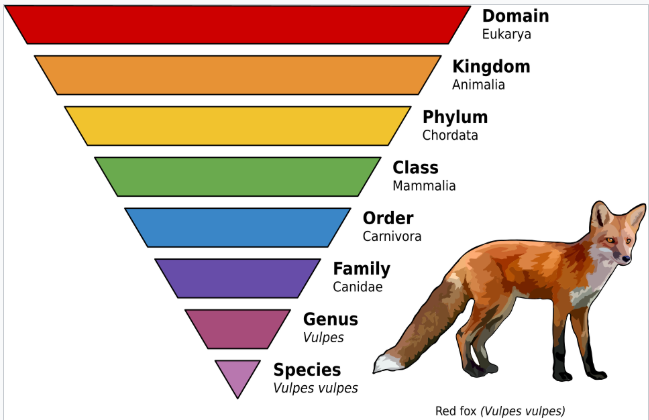Ecology and Species Classification: Key Concepts and Tools
1/72
There's no tags or description
Looks like no tags are added yet.
Name | Mastery | Learn | Test | Matching | Spaced |
|---|
No study sessions yet.
73 Terms
Ecology
The study of interactions between organisms and their environment.
Biome
A large geographical area with a characteristic climate, flora, and fauna.
Biosphere
The global sum of all ecosystems; all life on Earth and the environments they inhabit.
Ecosystem
A community of organisms interacting with each other and with their physical environment.
Community
All the different populations living and interacting in a specific area.
Population
A group of individuals of the same species living in the same area.
Individual
A single organism.
Species
A group of organisms that can interbreed and produce fertile offspring.
Binomial Nomenclature
The two-part scientific naming system using genus and species.
Dichotomous Key
A tool that helps identify organisms using a series of paired, opposite statements.
Genus
A taxonomic group containing one or more species that are closely related.
Organism
Any living thing.
Morphological Species
A species defined by physical characteristics (appearance/form).
Genetic Species
A species defined by genetic similarity and DNA analysis.
Ecological Species
A species defined by its ecological niche and role in the environment.
Taxonomy
The science of naming, classifying, and organizing organisms.
Classification of Species
The arrangement of species into groups based on shared characteristics.

DNA Surveys
Methods that analyze DNA to identify species present in an environment.
Biotic
Living components of an ecosystem.
Abiotic
Non-living physical and chemical components of an ecosystem.
Biotic Features of the Environment
Living factors such as plants, animals, fungi, and bacteria.
Abiotic Features of the Environment
Non-living factors such as temperature, light, soil, pH, and water.
Secchi Disk or Turbidity Tube
Tools used to measure water clarity (turbidity).
Light Meter or Lux Meter
Device used to measure light intensity.
Digital Thermometer or Temperature Probe
Instrument used to measure temperature accurately.
PH Probe or PH Test Kit
Tools used to measure acidity or alkalinity.
Soil Sieve Set or Sedimentation Test
Methods used to separate and analyze soil particle sizes.
Soil Moisture Probe or Gravimetric Method
Methods to measure soil moisture content.
PH
A measure of acidity or alkalinity (0-14).
Dissolved Oxygen
Amount of oxygen available in water for organisms.
Wave Action
Impact of waves on aquatic environments.
Turbidity
Cloudiness of water caused by suspended particles.
Salinity
Concentration of salt in water or soil.
Flow Velocity
Speed at which water flows in a river or stream.
Organic Content
Amount of decomposed organic material in soil or water.
Nitrates
Plant nutrients; high levels may indicate pollution.
Parasites
Organisms that live on or in a host and harm it.
Ecological Niche
An organism's role and interactions within its ecosystem.
Predation
A predator hunts and eats prey.
Herbivory
Animals feeding on plants.
Symbiosis
A close, long-term relationship between two species.
Mutualism
Both species benefit.
Commensalism
One benefits, the other is unaffected.
Parasitism
One benefits at the expense of the other.
Competition
Organisms compete for the same limited resources.
Intraspecific Competition
Competition within the same species.
Interspecific Competition
Competition between different species.
Competitive Exclusion Principle
No two species can occupy the same niche indefinitely.
Density Dependent Factors
Factors that intensify as population density increases.
Density Independent Factors
Factors that affect populations regardless of density.
Density Dependent Control
Regulation driven by density-dependent factors.
Density Independent Control
Regulation driven by non-density-dependent factors.
Limiting Factors
Factors that restrict population growth.
Carrying Capacity
The maximum population size an environment can support.
J-Shape Curve
Exponential population growth pattern.
S-Shape Curve
Logistic growth pattern leveling at carrying capacity.
Sampling Strategies
Methods for collecting data from a population.
Random Sampling
Every individual has an equal chance of being selected.
Systematic Sampling
Samples taken at regular intervals.
Transect Sampling
Sampling along a straight line to observe changes.
Motile Organisms
Organisms capable of movement.
Capture-Mark-Release-Recapture
Method to estimate population size.
Lincoln Index Formula
(N1 × N2) ÷ M2.
Pitfall Trap
Container used to trap small ground organisms.
Sweep Net
Net used to capture insects in vegetation.
Tree Beating
Shaking branches to collect falling organisms.
Tullgren Funnel
Device extracting organisms from soil or litter using heat.
Kick Sampling
Collecting aquatic organisms by disturbing substrate.
Camera Traps
Motion-triggered cameras to monitor wildlife.
Habitat
The natural environment where an organism lives.
Biomass
Total mass of living organisms in an area.
Keystone Species
A species with a disproportionately large effect on its ecosystem.
Tipping Point
A threshold where small changes cause major, irreversible shifts.